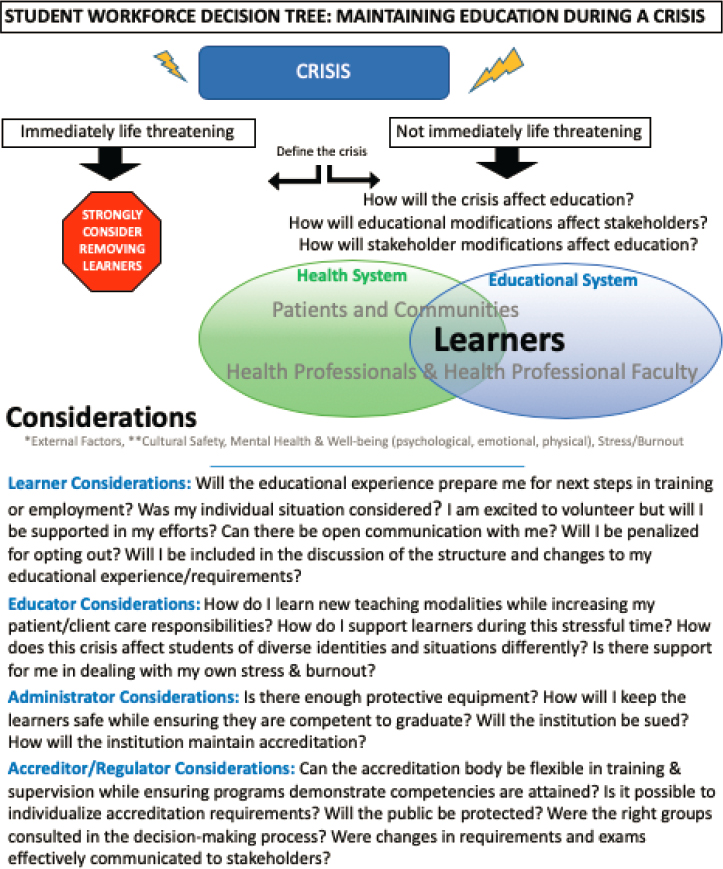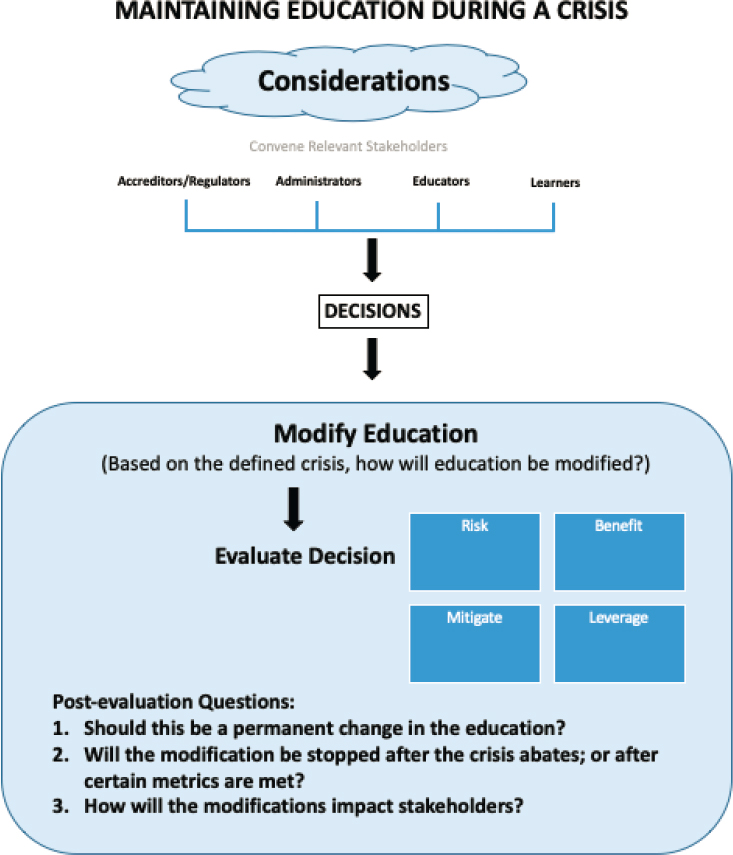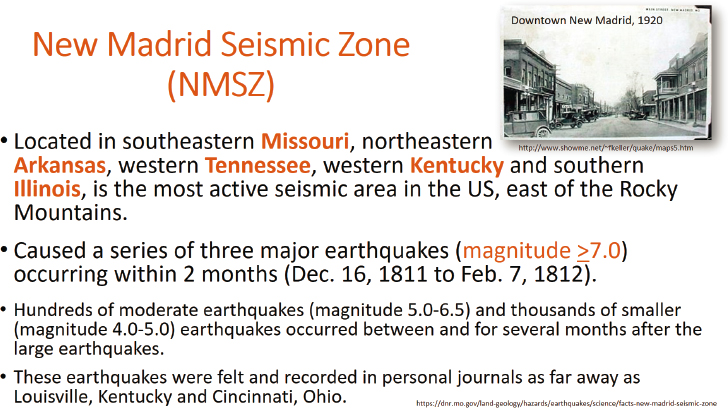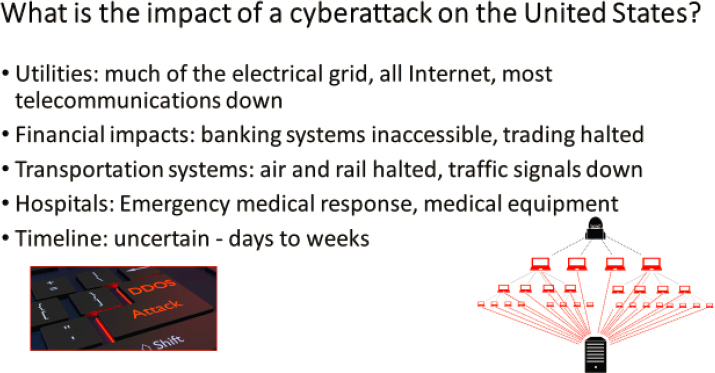7
Evolution of a Decision Tree
Session objective: To facilitate discussions around testing a decision tree, applicable across all the health professions.
PRESENTING A DECISION TREE
In this final session of the workshop series, participants tested a decision tree against three scenarios: an earthquake, a cyberattack, and a pandemic. Jonathan Amiel, Columbia University Vagelos College of Physicians and Surgeons, working with Robert Cain from the American Association of Colleges of Osteopathic Medicine, opened by walking participants through the decision tree that was used as a tool for deepening discussions throughout the workshop sessions (Figure 7-1).1
The first step is to understand and define the crisis, he said. If the situation is immediately life threatening, removing trainees from the danger zone is a rational decision. If it is not immediately life threatening, the next step is to consider how a decision will affect various stakeholders, including learners, educators, care providers, patients, and community members. At this point, said Amiel, there are three interdependent questions to consider:
- How will the crisis affect education?
- How will educational modifications affect stakeholders?
- How will stakeholder modifications affect education?
The next step is to review the stakeholder considerations, said Amiel, including considerations of learners, educators, regulators, and accreditors. It is here in the decision tree where stakeholders can come together to discuss and understand these stakeholder considerations before a decision is made. Evaluation of the decision is an important part of the process, Amiel noted, because decisions are not necessarily stagnant. During evaluation (shown in the blue box, Figure 7-2),2 it is also important to consider whether the changes should be temporary or permanent, when modifications should be changed, and how modifications might affect stakeholders. The decision tree was informed by workshop participants and speakers, said Amiel, for laying out key questions for stakeholders.
___________________
1 Robert Cain drafted the decision trees presented in this chapter based on the discussions of individual workshop participants at the various workshops sessions. The questions raised are those of the individual participants and do not necessarily represent the views of all workshop participants; the planning committee; or the National Academies of Sciences, Engineering, and Medicine, and the figure should not be construed as reflecting any group consensus.
2 This decision tree was drafted by Robert Cain and Lisa VanHoose based on the discussions of individual workshop participants at the various workshops sessions. The questions raised are those of the individual participants and do not necessarily represent the views of all workshop participants; the planning committee; or the National Academies of Sciences, Engineering, and Medicine, and the figure should not be construed as reflecting any group consensus.

SOURCE: Cain presentation, December 8, 2021.

SOURCE: Cain and VanHoose presentation, December 8, 2021.
TESTING A DECISION TREE WITH CASE STUDIES
Casey Shillam, dean and professor at the University of Portland School of Nursing, moderated the section of the session reporting on the application of a decision tree by testing three fictional case studies. In this final session of the workshop, participants broke into groups and discussed three crisis scenarios. Each group began by discussing the effect the crises would have on a local, national, or global level, then worked through a decision tree with their scenario. One representative from each group reported back to the larger group, providing a high-level overview of their discussions. Shillam emphasized the importance of focusing on how the crises would affect health professions learners and education. “Today’s learners are tomorrow’s health workforce,” she said, and it is critically important to evaluate the lessons learned from the COVID-19 pandemic to be better prepared for the next crisis.
Regional Crisis: An Earthquake in the New Madrid Seismic Zone
A large earthquake in the New Madrid seismic zone (located in the south and Midwestern United States, see Figures 7-3 and 7-4) is an event that needs to be planned for now, said Lisa VanHoose, from the Ujima Institute.
Such planning requires holding interdisciplinary, transdisciplinary, and multidisciplinary conversations about crisis management, along with

SOURCE: Vanhoose and Cain presentation, December 8, 2021.

SOURCE: Amiel and Patel presentation, December 8, 2021.
budgetary planning to prepare for the response. In parallel with these discussions, there is a need for conversations with and about patients in the community. “We have a commitment to the learner,” said VanHoose, but ultimately, our commitment is to take care of the community. The group participants also discussed the need for increased attention to mental health within both the educational system and the health care system. Finally, said VanHoose, during COVID-19, the reliance on technology increased in order to continue health education and practice. In the event of a large earthquake, however, technology may not be available; it is critical that there are plans in place for this situation.
National Crisis: Dealing with a Cyberattack
The second group discussed a scenario in which a cyberattack renders many communication systems unavailable and disrupts the power grid (Figure 7-4).
The return to normalcy varies by setting, with some systems coming back online within days and others not for months. In this situation, learners’ needs must be attended to and there needs to be flexibility based on individual circumstances. Using a decision tree, he said, the group determined it was not a life-threatening circumstance so it was appropriate to make modifications to permit and enhance learner participation within the health and educational systems. It would be critical to assess and map
learners’ competencies to know what roles they could take on, said Amiel; “we can’t assume a level of competency.” This is something, said Amiel, we can do before a crisis strikes. There is a need for a “culture of assessment,” in which there is ongoing evaluation of where learners are, what type of supervision is necessary, and what skills they are ready to use in practice. Most importantly, he said, “we need to center the needs of patients.” The responsibility is to society, and educators need to ensure learners understand that “service is at the core of what we are doing and that may mean that educational paths aren’t as linear as sometimes we’d like them to be.”
Global Crisis: COVID-19 Mutations Render Vaccines and Therapeutics Ineffective
The third group discussed a scenario in which COVID-19 mutations render vaccines ineffective (Box 7-1).
“You cannot have a discourse about the learner without the learner,” said Kenya Beard of Chamberlain University. If COVID-19 mutations result in another crisis situation, it is critical to include the learner in decision making from the beginning. To protect and promote learners’ mental health, “We have to be mindful of their absorption capacity and their saturation level.” It is also important to pay attention to the unintended messages that are sent via the actions of health professionals and educators. For example, when learners were pulled out of the clinical environment,
Beard reflected, administrators sent a “message that they can leave when things are hard.”
The participants also discussed how the crisis created additional burdens and how some students were marginalized. For example, those who did not have easy access to the Internet were less able to participate in remote learning. Another powerful area of conversation, said Beard, was about the importance of strong community partnerships. During a crisis, learners’ energy and enthusiasm can be used in new and different ways by leaning on and supporting these relationships. “When we have to change during a crisis,” said Beard, “we cannot just go with the old model.”
DISCUSSION
Following the breakout group report, Shillam led a discussion on how to take the lessons learned from COVID-19 and use them to inform planning for the next crisis. Shillam began by emphasizing “the time is now” to include learners in contingency planning for the future. By including students in these conversations, they will understand the potential paths their education may take. Jeremiah McGuire, University of Oklahoma, followed Shillam’s comment saying that including students can help mitigate some of the mental health implications of a crisis situation. “When we give people that autonomy,” they are better able to deal with the situation. Furthermore, he said, there is a need to look at the educational system through a new lens, in which both learners and faculty have a voice, have resources to share, and can rely on each other.
Yoni Siden from the University of Michigan concurred with this perspective, noting those institutions that were able to succeed during the pandemic “viewed students from an assets perspective, as opposed to getting in the way of health care.” Institutions that viewed students as “getting in the way” sent messages about learners’ professional identities and the value that they bring. There have been many incredible examples of how learners have contributed to addressing COVID-19 and how learners have gained new competencies through this work. When learners were brought into the process in “safe and appropriate ways,” they were able to get a firsthand view of the health system and how it adapts and reacts to a crisis. Siden felt his experiences during the pandemic “forever changed” his learning and his professional practice. He added that students will experience crises differently, depending on their identities, their exposures, and their professional background. Shillam underscored this last reflection saying we cannot make assumptions about our learners and we need to include the “totality of the identity” of all our learners.
Another important piece moving forward, Shillam said, is to learn lessons from the decisions and experiences of other countries. Beard
mentioned the value of a global lens. There are many examples of resource-poor countries, she said, that were successful in distributing the vaccine to their vulnerable populations, and the United States should learn from these experiences. Another participant supported Beard’s view, adding that people in low- and middle-income countries have been dealing with resource constraints for a long time and have found ways to overcome them. The United States could learn from these global colleagues.
Jasmine L. Garland McKinney, University of North Carolina Greensboro, said it is important to broaden our conceptualization of the health professions workforce, in particular, the training of mental health providers. With COVID-19 and other crises on the horizon, there will be mental health implications, so “we need to have very well-trained mental health providers” to address the issue.
APPLICATION OF A DECISION TREE
While people are exhausted from COVID-19 and not ready to think about the next crisis, said Erin Patel of the Veterans Health Administration, this is the time to prepare health and education systems and learners for what is to come. To deepen the conversation about decision making, Shillam used the decision tree as a tool and asked participants for their feedback on using a decision tree (Figure 7-1). Amiel said the tree was helpful in grounding the group’s conversation, in particular because it recognized multiple perspectives and the dynamic evolution of a crisis. He noted that using an equity lens in decision making is critical but also complex because of the inherent shortage of resources during a crisis. Being “exquisitely attuned” to the needs of learners—in particular the most vulnerable learners—will be tremendously important while trying to serve the needs of our most vulnerable patients, he said.
VanHoose agreed that a decision tree was a useful tool to guide the conversation, in particular the questions that needed additional consideration for each role. Her group saw an opportunity to create more space for the patient and the community component of the conversation, and to identify ways to better engage with these stakeholders. Garland McKinney conveyed the discussion from her group, saying one participant felt this decision tree “might benefit from a more explicit graphic reminding the viewer or user of equities, and of the need to address the nuanced identities and needs of the learner.”
FUTURE ASPIRATIONS
In closing, Shillam encouraged workshop participants to foster the leadership potential in learners. Students have “so much potential to make
an incredible difference in our world,” she said, and this is the time to take the opportunity to use them as a resource and a voice for change. Amiel added that planning for a crisis now will not only help us be prepared for a future crisis, but it will also strengthen what exists today by delineating competencies and assessments to ensure all learners are able to serve in their roles as health professionals now and in the future.
This page intentionally left blank.












